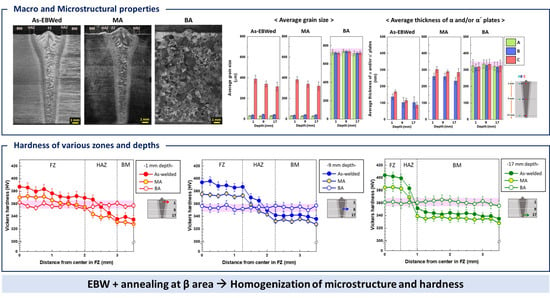Annealing Heat Treatment for Homogenizing the Microstructure and Mechanical Properties of Electron-Beam-Welded Thick Plate of Ti-6Al-4V Alloy
Abstract
:1. Introduction
2. Materials and Process Method
2.1. Materials and Electron-Beam-Welding Process
2.2. Post-Weld Heat Treatment
2.3. Analysis
3. Results and Discussion
3.1. Microstructure Evolution
3.1.1. Macrostructure
3.1.2. Microstructure
3.2. Mechanical Property
3.2.1. Hardness Profile
3.2.2. Tensile Properties
4. Conclusions
- 1.
- In EBWed thick plates, the FZ, HAZ, and BM zones are divided. FZ is shown to comprise α′ and/or widmanstätten α and β, and α′ is dominant in areas far from the upper surface of the FZ. After MA, α′ in EBWed sample is transformed to widmanstätten α and β, but the divided zones still remain. Meanwhile, BA sees microstructural homogenization to fully widmanstätten α and β in transformed β, so there are no divided zones or gradients of phases over the entire area, and the microstructural characteristics at each depth are insignificant compared to solely EBWed and MA.
- 2.
- The Micro-Vickers hardness of EBWed is increased from BM to FZ, as well as far from the upper surface. After MA, the gradients of the hardness profile according to each zone and depth are smaller than for EBWed. However, after BA, the hardness values are similar across the entire area, so there are insignificant gradients. The BA heat-treated sample has a higher tensile strength than the others.
Author Contributions
Funding
Institutional Review Board Statement
Informed Consent Statement
Data Availability Statement
Acknowledgments
Conflicts of Interest
References
- Foltz, J. Introduction to titanium and its alloys. In Heat Treating of Nonferrous Alloys; Totten, G.E., Machenzie, D.S., Eds.; ASM International: Novelty, OH, USA, 2016; Volume 4E, pp. 481–497. [Google Scholar]
- Boyer, R.; Collings, E.W.; Welsch, G. (Eds.) Materials Properties Handbook: Titanium Alloys; ASM International: Novelty, OH, USA, 1994; pp. 528–530. [Google Scholar]
- Lűtjering, G.; Williams, J.C. Titanium, 2nd ed.; Derby, B., Ed.; Springer: Berlin, Germany, 2007; pp. 1–14. [Google Scholar]
- Fomin, F.; Ventzke, V.; Dorn, F.; Levichev, N.; Kashaev, N. Effect of microstructure transformations on fatigue properties of laser beam welded Ti-6Al-4V butt joints subjected to postweld heat treatment. In Study of Grain Boundary Character; Tanski, T., Borek, W., Eds.; IntechOpen: London, UK, 2017; pp. 111–141. [Google Scholar]
- Balasubramanian, T.S.; Balakrishnan, M.; Balasubramanian, V.; Muthu Manicham, M.A. Effect of welding processes on joint characteristics of Ti-6Al-4V alloy. Sci. Technol. Weld. Join. 2011, 16, 702–708. [Google Scholar] [CrossRef]
- Yunilian, Q.; Ju, D.; Quan, H.; Liying, Z. Electron beam welding, laser beam welding and gas tungsten arc welding of titanium sheet. Mater. Sci. Eng. A 2000, 280, 177. [Google Scholar] [CrossRef]
- Saresh, N.; Gopalakrishna Pillai, M.; Jose, M. Investigations into the effects of electron beam welding on thick Ti-6AL-4V titanium alloy. J. Mater. Process Technol. 2007, 192, 83. [Google Scholar] [CrossRef]
- Liu, C.; Wu, B.; Zhang, J.X. Numerical investigation of residual stress in thick titanium alloy plate joined with electron beam welding. Met. Mater. Trans. B 2010, 41, 1129–1138. [Google Scholar] [CrossRef]
- Liu, C.; Zhang, J.X.; Wu, B.; Gong, S.L. Numerical investigation on the variation of welding stresses after material removal from a thick titanium alloy plate joined by electron beam welding. Mater. Des. 2012, 34, 609–917. [Google Scholar] [CrossRef]
- Yu, B.B.; Chen, Z.Y.; Zhao, Z.B.; Liu, J.R.; Wang, Q.J.; Li, J. Microstructural and mechanical properties of electron beam weldment of Titanium alloy TC17. Acta Met. Sin. 2016, 54, 831–841. [Google Scholar]
- Lize Li, S.W.; Huang, W.; Jin, Y. Microstructure and mechanical properties of electron beam welded TC4/TA7 dissimilar titanium alloy joint. J. Manuf. Process 2020, 50, 295–304. [Google Scholar]
- Gao, F.; Li, P.; Jiang, P.; Lia, Z.N. The effect of constraint conditions on microstructure and properties of titanium alloy electron beam welding. Mater. Sci. Eng. A 2018, 721, 117–124. [Google Scholar] [CrossRef]
- Babu, N.K.; Sunara Raman, S.G.; Murthy, C.V.S.; Reddy, G.M. Effect of beam oscillation on fatigue life of Ti-6Al-4V electron beam weldments. Mater. Sci. Eng. A 2007, 471, 113–119. [Google Scholar] [CrossRef]
- Tsai, C.J.; Wang, L.M. Improved mechanical properties of Ti-6AL-4V alloy by electron beam welding process plus annealing treatments and its microstructural evolution. Mater. Des. 2014, 60, 587–598. [Google Scholar] [CrossRef]
- Wang, G.; Chen, Z.; Li, J.; Wang, Q.; Yang, R. Microstructure and mechanical properties of electron beam welded titanium alloy Ti-6246. Mater. Sci. Technol. 2018, 34, 570–576. [Google Scholar] [CrossRef]
- Lu, Y.; Turner, R.; Cai, B.; Fang, C.; Wang, F.; Chiu, Y.; Brooks, J.; Basoalto, H. Microstructural, Mechanical and In-Situ Evaluations of Electron Beam Welded Ti-6Al-4V Alloy after Post-Weld Heat Treatments. Available online: https://ssrn.com/abstract=4357945 (accessed on 14 February 2023).
- Lu, W.; Shi, Y.; Lei, Y.; Li, X. Effect of electron beam welding on the microstructures and mechanical properties of thick TC4-DT alloy. Mater. Des. 2012, 34, 509–515. [Google Scholar] [CrossRef]
- Li, J.N.; Li, J.S.; Qi, W.J.; Liu, K.G. Characterization and mechanical properties of thick TC4 titanium alloy sheets welded joint by vacuum EBW. Vacuum 2019, 168, 10882. [Google Scholar] [CrossRef]
- Liu, H.; Wang, H.; Zhang, Z.; Liu, Y.; Huang, Z.; Wang, Q.; Chen, Q. Tensile and fatigue behavior of electron beam welded TC17 titanium alloy joint. Int. J. Fatigue 2019, 128, 105210. [Google Scholar] [CrossRef]
- Zhang, S.; Ma, Y.; Huang, S.; Youssef, S.S.; Qi, M.; Wang, H.; Qiu, J.; Lei, J.; Yang, R. Temperature-gradient induced microstructure evolution in heat-affected zone of electron beam welded Ti-6Al-4V titanium alloy. J. Mater. Sci. Technol. 2019, 35, 1681–1690. [Google Scholar] [CrossRef]
- Xu, C.; Liu, H.Q.; Li, C.H.; Yang, H.J.; Shao, X.H.; Ma, X.L. Internal tensile properties of characteristic zones in the electron beam weldment of TIC17 titanium alloy. Mater. Sci. Eng. A 2023, 875, 145087. [Google Scholar] [CrossRef]
- Tao, J.; Hu, S.; Ji, L. Effect of micromorphology at the fatigue crack tip on the crack growth in electron beam welded Ti-6Al-4V joint. Mater. Charact. 2016, 120, 185–194. [Google Scholar] [CrossRef]
- Liu, H.; Wang, H.; Zhang, Z.; Huang, Z.; Liu, Y.; Wang, Q.; Chen, Q. Enhancing the mechanical properties of electron beam welded TC17 titanium, alloy joint by post-weld heat treatment. J. Alloys Compd. 2019, 810, 151937. [Google Scholar] [CrossRef]
- Liu, H.; Song, J.; Cao, X.; Xu, L.; Du, Y.; Li, L.; Wang, Q.; Chen, Q. Enhancement of fatigue resistance by direct aging treatment in electron beam welded Ti-5Al-2Sn-2Zr-4Mo-4Cr alloy joint. Mater. Sci. Eng. A 2022, 829, 142168. [Google Scholar] [CrossRef]
- Pillai, M.G.; Sreejith, P.S.; Gupta, R.K.; Pant, B.; Dileep, N. Microstructure and mechanical propertoes of Ti6Al4V alloy electron beam weldment at varying heat treatment conditions. Trans. Indian Inst. Met. 2020, 73, 1879–1890. [Google Scholar] [CrossRef]
- Yang, Z.; Li, J.; Zhang, B.; Li, J. Microstructures and mechanical properties of a titanium alloy thick plate joint after electron beam welding plus solution-aging. J. Mater. Res. Technol. 2022, 19, 913–922. [Google Scholar] [CrossRef]
- Kumar, V.A.; Gupta, R.K.; Manwatkar, S.K.; Ramkumar, P.; Venkitakrishnan, P.V. Effect of prior and post-weld heat treatment on electron beam weldments of (α+β) titanium alloy Ti-5Al-3Mo-1.5V. J. Mater. Eng. Perform. 2016, 25, 2147–2156. [Google Scholar] [CrossRef]
- Mendez, P.F.; Eager, T.W. Welding processes for aeronautics. Adv. Mater. Process 2001, 159, 39–43. [Google Scholar]
- AMS. Titanium Alloy Bars, Wire, Forgings, Rings, and Drawn Shapes 6Al-4V, Annealed; 4928w; SAE Specification: Warrendale, PA, USA, 2017. [Google Scholar] [CrossRef]
- AMS. Titanium Alloy Damage-Tolerant Grade Plate 6Al-4V Beta Annealed; 4905w; SAE Specification: Warrendale, PA, USA, 2017. [Google Scholar] [CrossRef]
- ASTM E112-13; Standard Test Methods for Determining Average Grain Size. ASTM International: West Conshohocken, PA, USA, 2021.
- Bu, H.; Gau, Q.; Li, Y.; Wang, F.; Zhan, X. Comparative study on microstructure and aluminum distribution between laser beam welding and electron beam welding of i-6Al-4V alloy pates. Met. Mater. Int. 2021, 27, 3449–3461. [Google Scholar] [CrossRef]
- Abioye, T.E.; Zuhailawati, H.; Aizad, S.; Anasyida, A.S. Geometrical, microstructural and mechanical characterization of pulse laser welded thin sheet 5052-H32 aluminum alloy for aerospace applications. Trans. Nonferrous Met. Soc. 2019, 29, 667–679. [Google Scholar] [CrossRef]
- Vikas, K.S.R.; Rahul; Venkata Ramana, V.S.N.; Reddy, G.M.; Rao, K.S. Effect of heat treatments on tensile fracture bahaviour of Ti-6Al-4V alloy friction welds. J. Ins. Eng. India Ser. D 2023, 1–19. [Google Scholar] [CrossRef]
- Vikas, K.S.R.; Rao, K.S.; Rahul; Reddy, G.M.; Venkata Ramana, V.S.N. Influence of heat treatments on microstructural and mechanical properties of Grade 5 titanium friction welds. Eng. Res. Express 2022, 4, 025053. [Google Scholar] [CrossRef]
- JMatPro, version 13.0.0; Sente Software Corp.: Guildford, UK, 2021.
- Wang, X.; Wei, S.; Wang, X.; Chang, K.; Yang, H.; Wang, Y. Synergetic improvements in surface hydrophobicity and wear resistance of TC4 materials via the combination of rapid heating and EtOH quenching methods. J. Alloys Compd. 2024, 970, 172582. [Google Scholar] [CrossRef]
- Gao, Y.; Deng, S.Q.; Yang, F.; Sun, D.J.; Gao, K.; An, L.N. High hardness and high toughness WQ-Fe-Ni Cemented Carbides Prepared by hot oscillating pressing. Adv. Eng. Mater. 2023, 25, 2201535. [Google Scholar] [CrossRef]
- Kabir, A.S.H.; Cao, X.; Gholipour, J.; Wanjara, P.; Cuddy, J.; Birur, A.; Medraj, M. Effect of postweld heat treatment on microstructure, hardness, and tensile properties of laser-welded Ti-6Al-4V. Met. Mater. Trans. A 2012, 43A, 4171. [Google Scholar]
- Lv, H.; Li, D.; Li, Y.; Li, X. Hot tensile deformation behavior of Ti-6Al-4V titanium alloy made by laser melting depositon. Machines 2022, 10, 553. [Google Scholar] [CrossRef]
- Jiang, Y.Q.; Lin, Y.C.; Jiang, X.Y.; He, D.G.; Zhang, X.Y. Hot tensile properties, microstructure evolution and fracture mechanisms of Ti-6Al-4V alloy with initial coarse equiaxed phases. Mater. Charact. 2020, 163, 110272. [Google Scholar] [CrossRef]
- Liu, Z.; Zhao, Z.B.; Wang, L.; Zhu, S.X.; Yang, G.; Gong, S.L.; Wang, Q.J.; Yang, R. Deformation behaviors of as-built and hot isostatically pressed Ti-6Al-4V alloys fabricated via electron beam rapid manufacturing. J. Mater. Sci. Technol. 2019, 35, 2552–2558. [Google Scholar] [CrossRef]
- Dang, N.; Chen, S.; Liu, L.; Maire, E.; Adrien, J.; Cazottes, S.; Xiao, W.; Ma, C.; Xhou, L. Anaysis of hybrid fracture in α/β titanium alloy with lamellar microstructure. Mater. Sci. Eng. A 2019, 744, 54–63. [Google Scholar] [CrossRef]
- Pang, J.C.; Li, S.X.; Wang, Z.G.; Zhang, Z.F. Relations between fatigue strength and other mechanical properties of metallic materials. Fatigue Fract. Eng. Mater. Struct. 2014, 37, 958–976. [Google Scholar] [CrossRef]
- Huang, L.J.; Qi, L.C.; Liu, C.K.; Liu, D.L.; Huang, X. Relation between fatigue limit and tensile strength of Ti-1023 titanium. Chin. J. Nonferr. Met. 2010, 20, 54–57. [Google Scholar] [CrossRef]
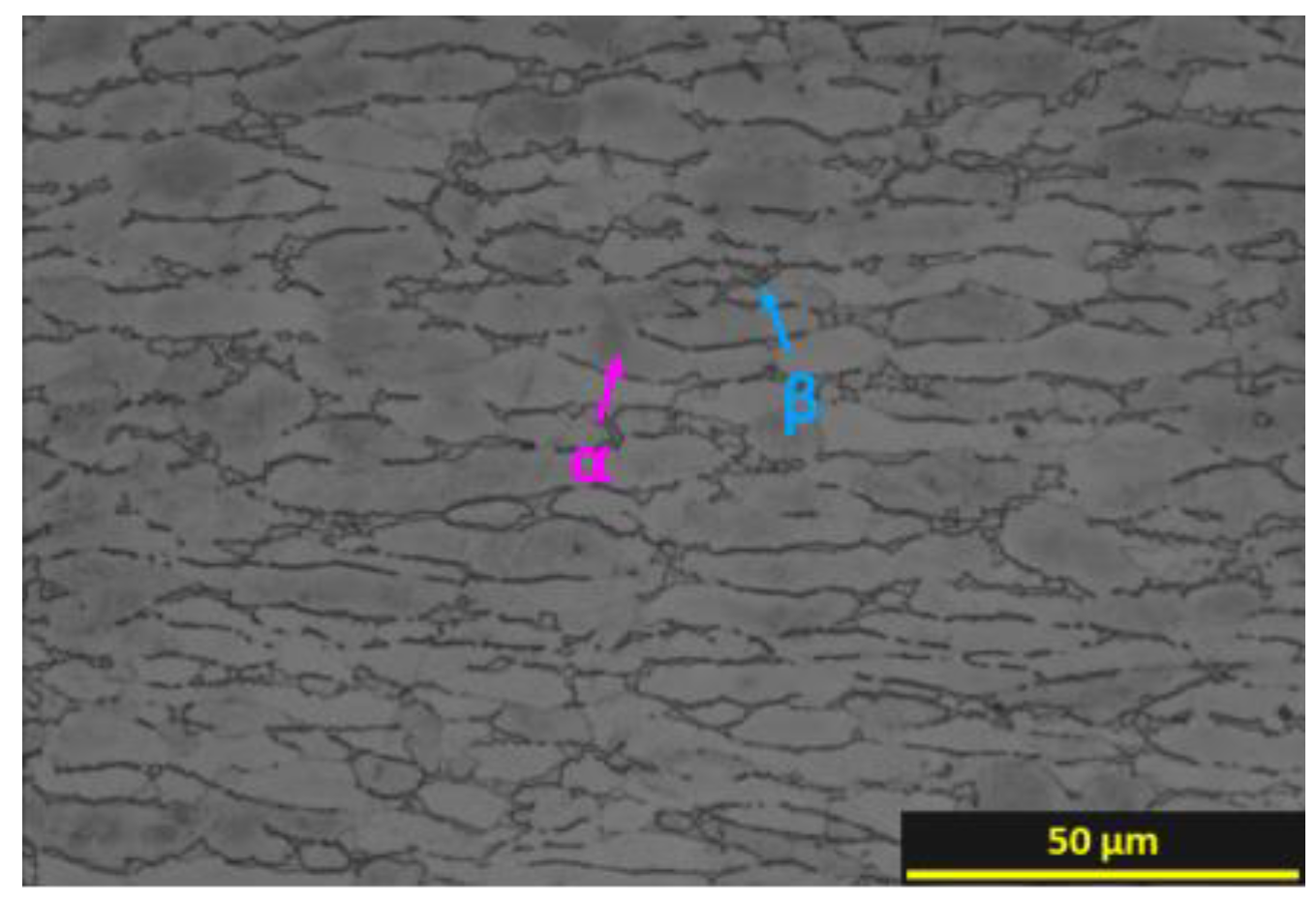
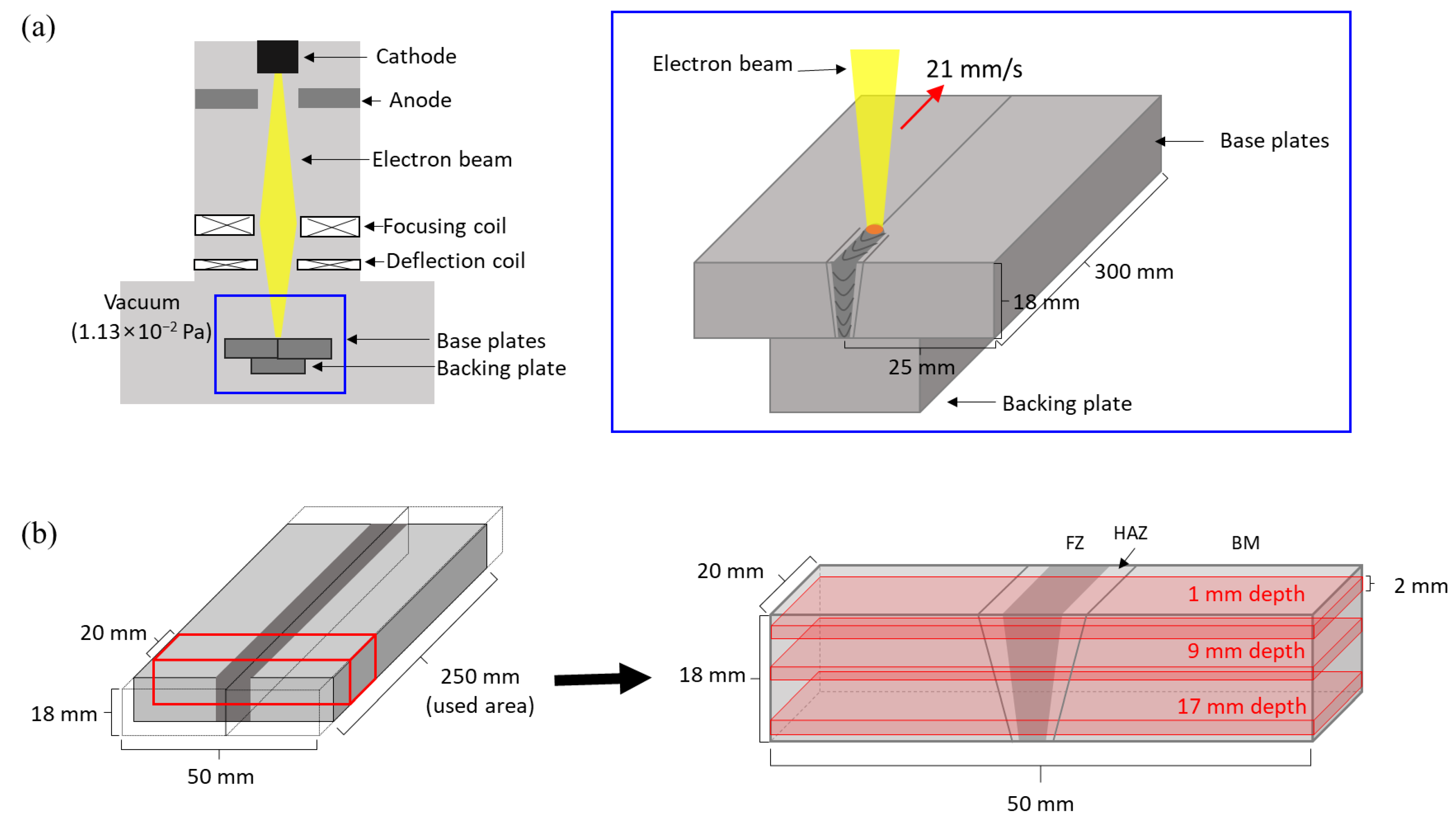


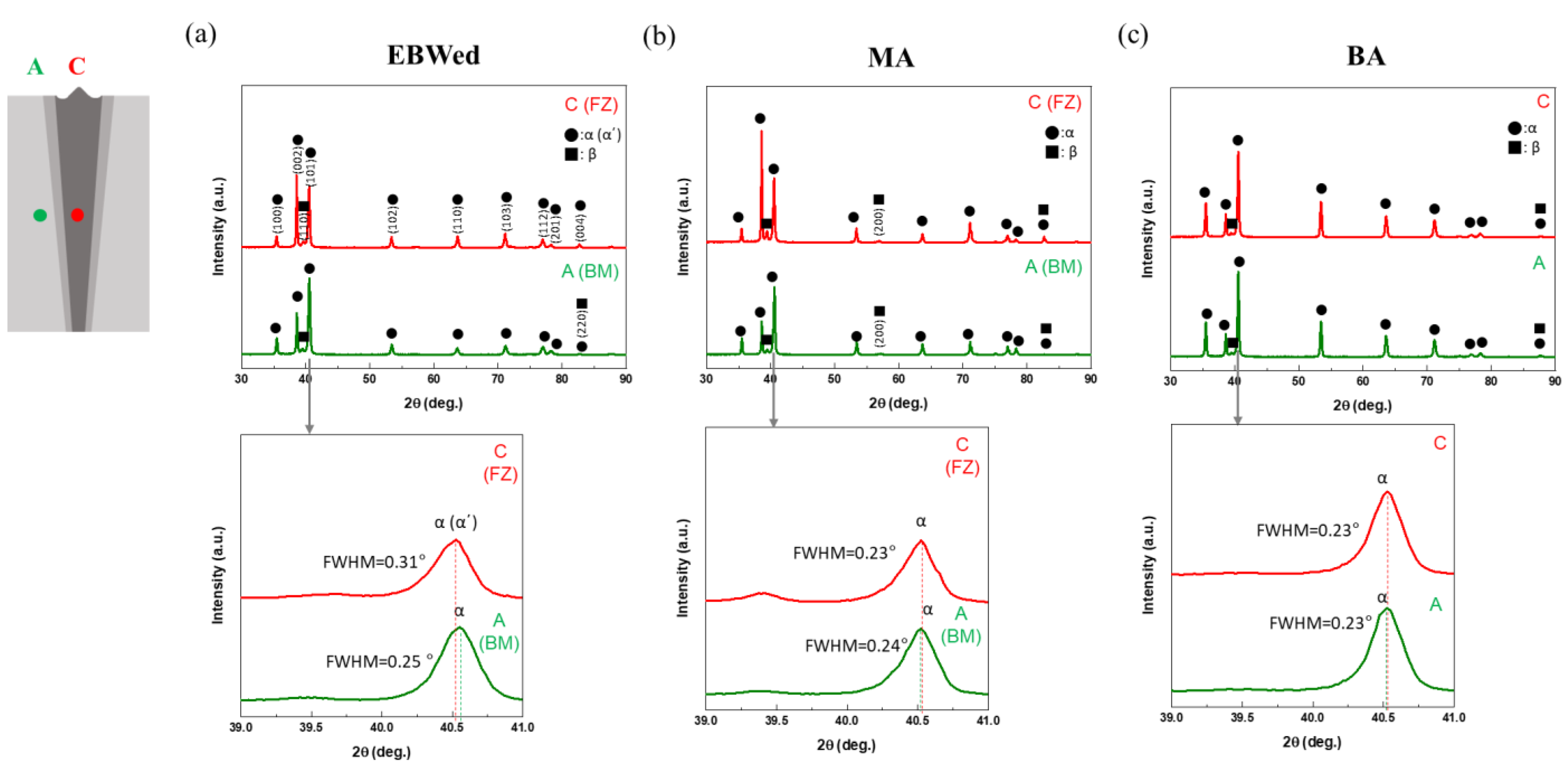
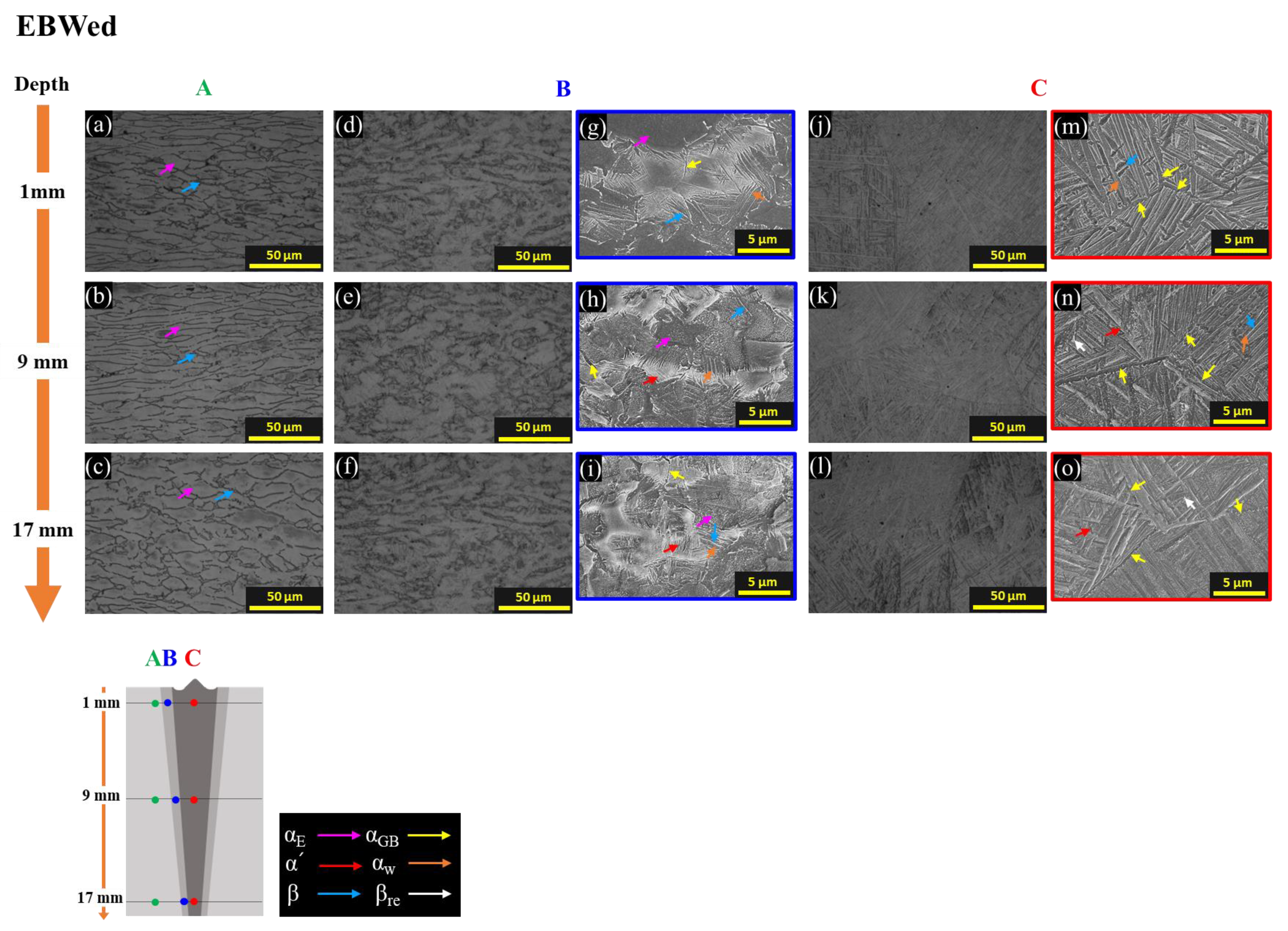
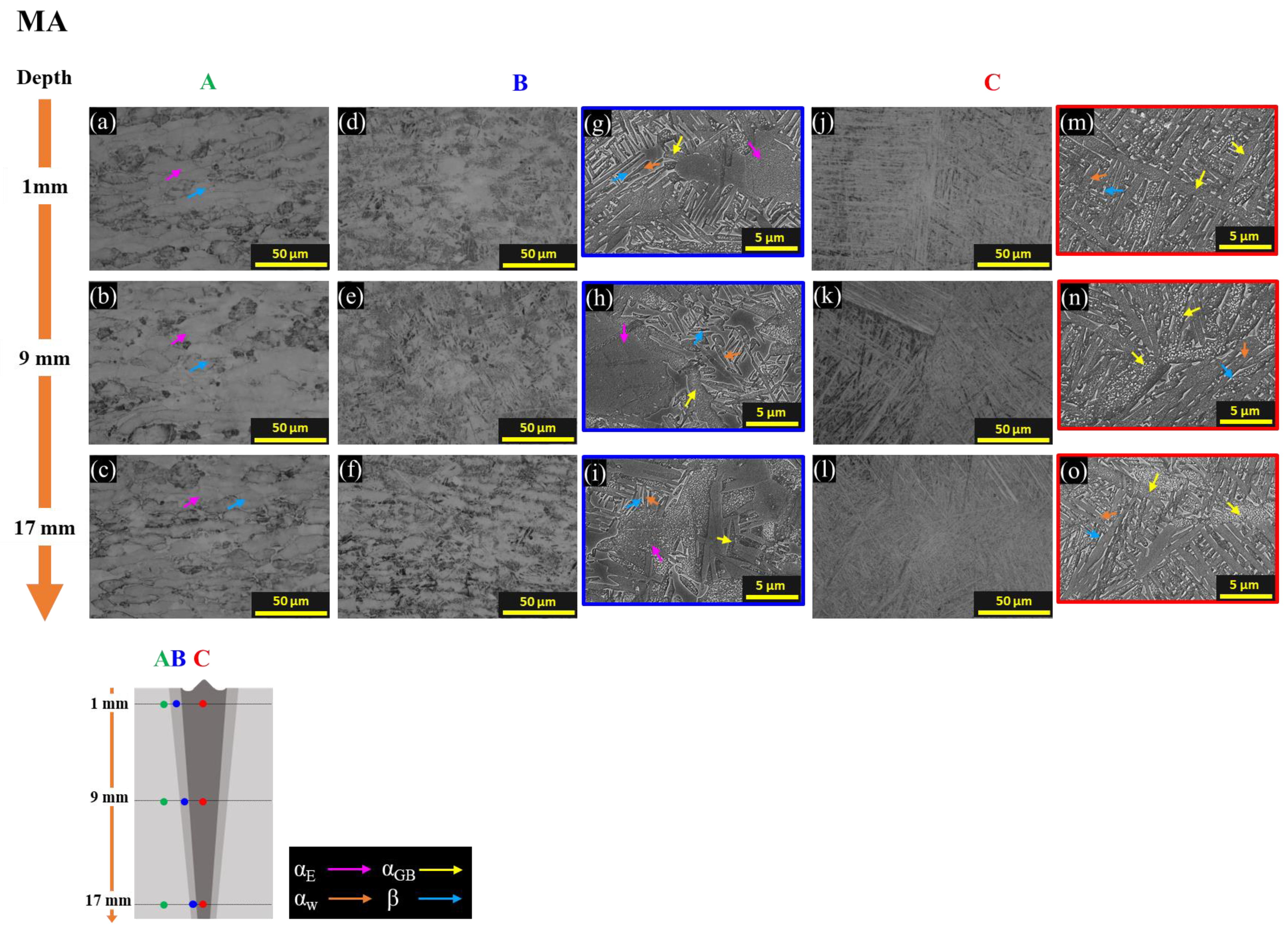
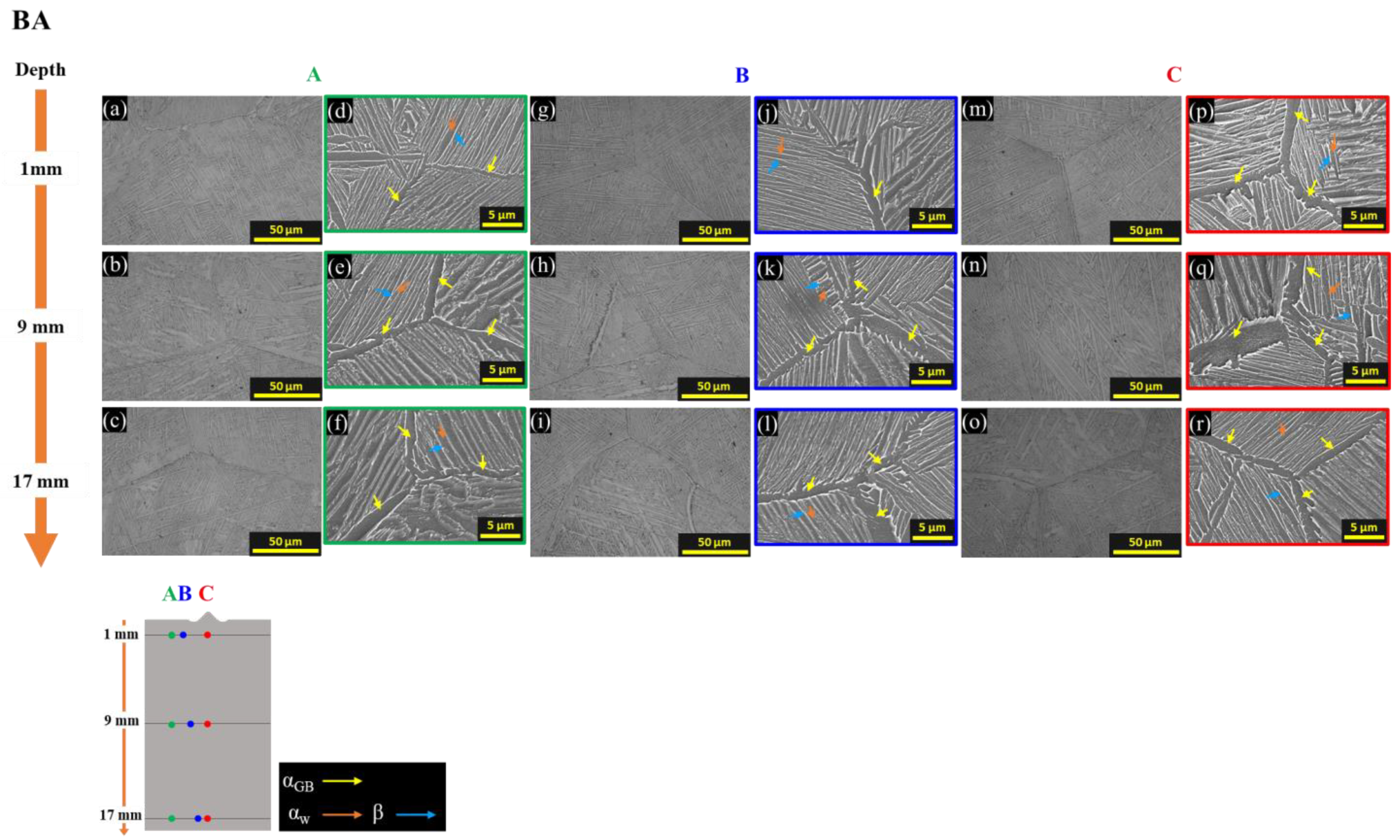


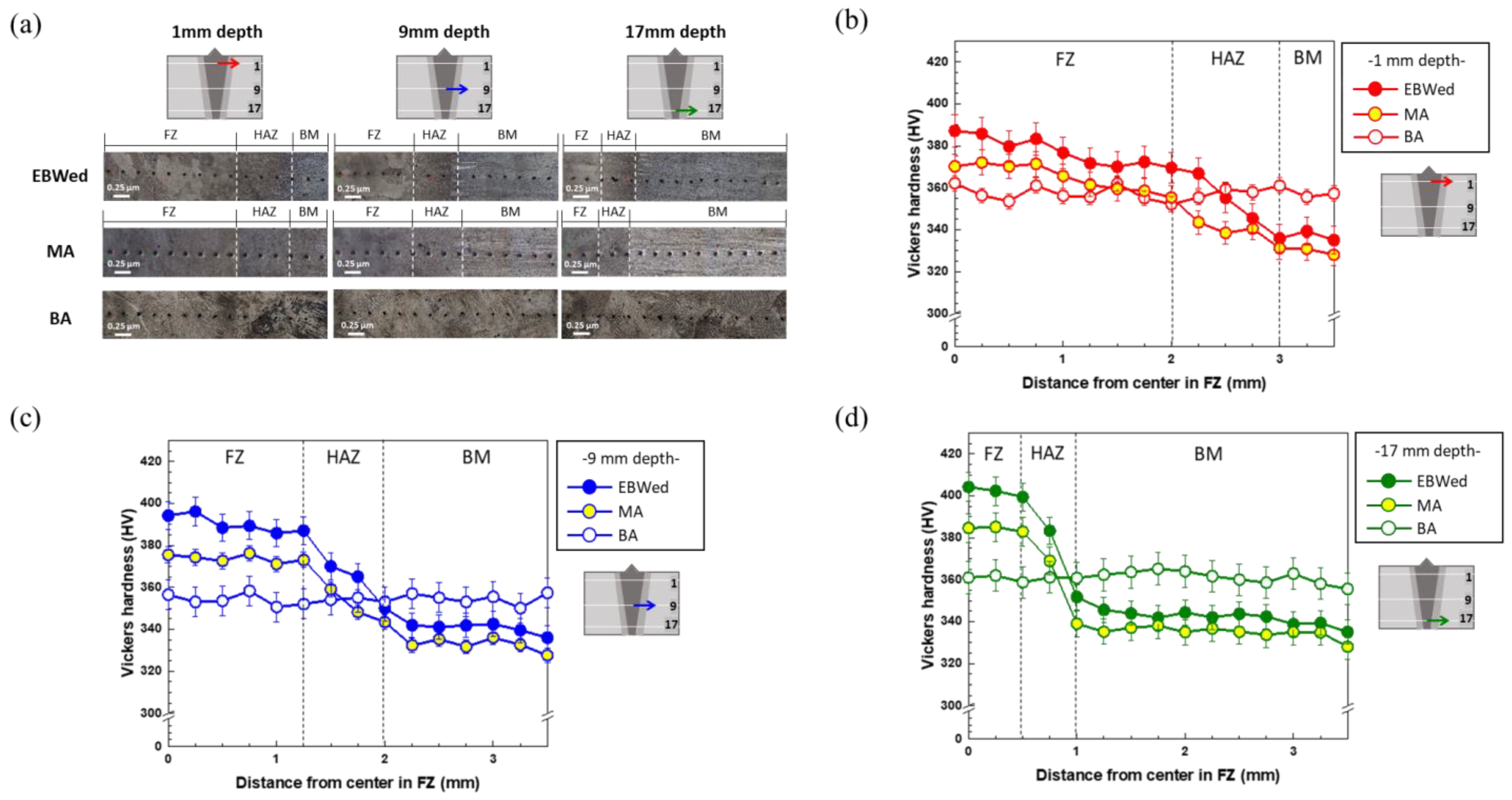


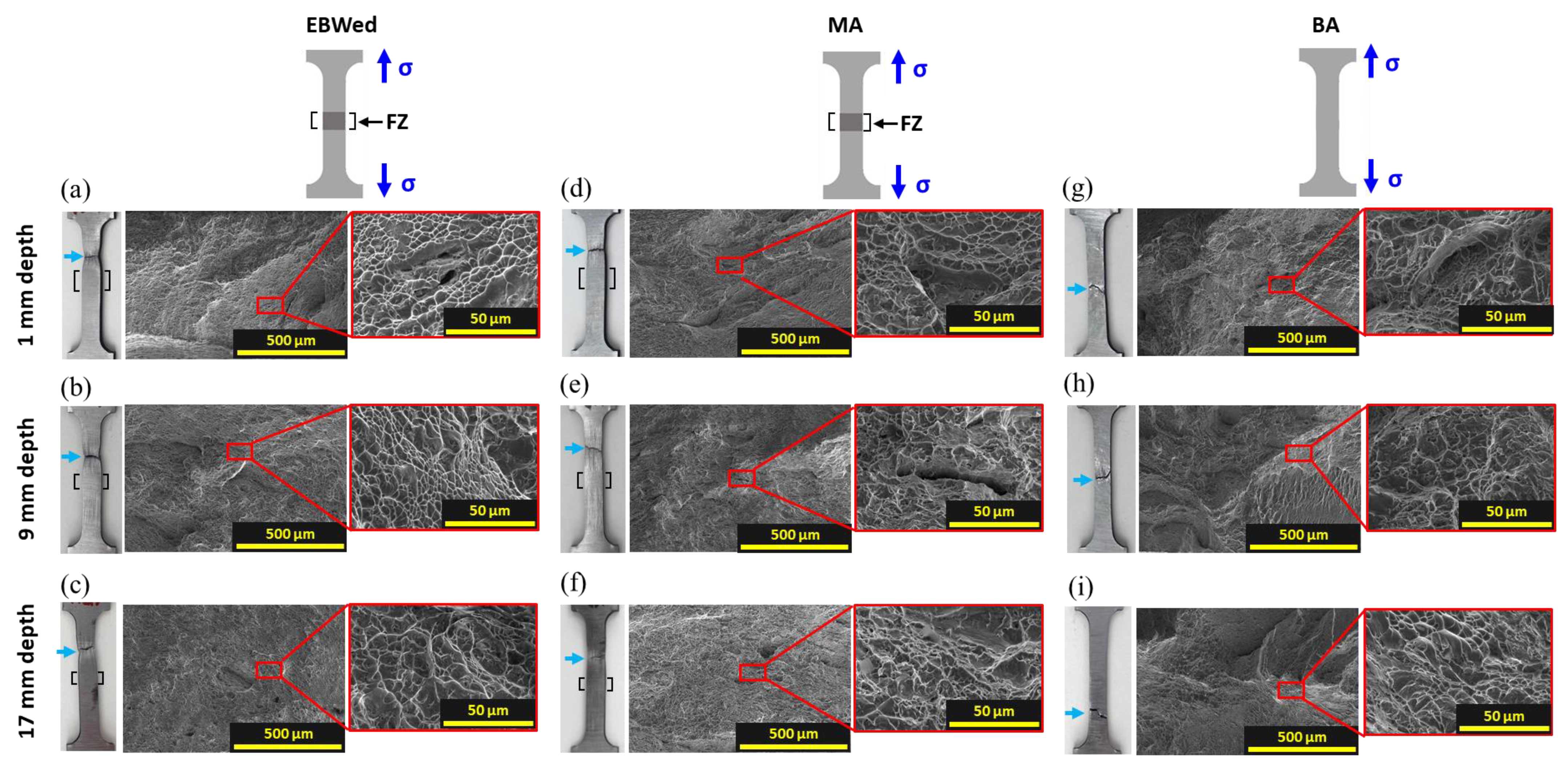
| Ti | C | Al | V | Fe | O | H | N |
|---|---|---|---|---|---|---|---|
| Bal. | 0.005 | 6.25 | 4.1 | 0.21 | 0.11 | <0.0003 | 0.004 |
| Voltage (kV) | Current (mA) | Power (kW) | Speed (mm/s) | Vacuum Level (Pa) |
|---|---|---|---|---|
| 54 | 150 | 8.1 | 21 | 1.13 × 10−2 |
| Temperature (°C) | Time (h) | Cooling Condition | |
|---|---|---|---|
| Mill annealing (MA) | 730 | 2 | AC |
| β annealing (BA) | 1030 | 0.5 | AC |
| Depth (mm) | FZ (C Zone) | BM (A Zone) | |||
|---|---|---|---|---|---|
| Horizontal (μm) | Vertical (μm) | Horizontal (μm) | Vertical (μm) | ||
| EBWed | 1 | 49.83 | 50.59 | 53.57 | 53.45 |
| 9 | 49.45 | 50.21 | 53.76 | 53.76 | |
| 17 | 48.26 | 48.11 | 54.02 | 53.38 | |
| MA | 1 | 51.73 | 51.92 | 54.00 | 55.69 |
| 9 | 51.23 | 51.86 | 53.13 | 54.69 | |
| 17 | 50.59 | 50.72 | 55.28 | 54.86 | |
| BA | 1 | 51.51 | 51.12 | 50.48 | 50.07 |
| 9 | 51.80 | 52.50 | 51.92 | 52.50 | |
| 17 | 50.53 | 51.10 | 50.51 | 51.16 | |
| Tensile Strength (MPa) | Elongation (%) | |||||
|---|---|---|---|---|---|---|
| EBWed | MA | BA | EBWed | MA | BA | |
| 1 mm depth | 965.82 | 957.25 | 994.0 | 9.0 | 10.2 | 9.6 |
| 9 mm depth | 976.24 | 952.0 | 992.07 | 9.7 | 10.1 | 9.9 |
| 17 mm depth | 975.15 | 958.65 | 997.50 | 9.3 | 10.5 | 9.8 |
Disclaimer/Publisher’s Note: The statements, opinions and data contained in all publications are solely those of the individual author(s) and contributor(s) and not of MDPI and/or the editor(s). MDPI and/or the editor(s) disclaim responsibility for any injury to people or property resulting from any ideas, methods, instructions or products referred to in the content. |
© 2023 by the authors. Licensee MDPI, Basel, Switzerland. This article is an open access article distributed under the terms and conditions of the Creative Commons Attribution (CC BY) license (https://creativecommons.org/licenses/by/4.0/).
Share and Cite
Seo, S.; Park, J. Annealing Heat Treatment for Homogenizing the Microstructure and Mechanical Properties of Electron-Beam-Welded Thick Plate of Ti-6Al-4V Alloy. Materials 2023, 16, 7423. https://doi.org/10.3390/ma16237423
Seo S, Park J. Annealing Heat Treatment for Homogenizing the Microstructure and Mechanical Properties of Electron-Beam-Welded Thick Plate of Ti-6Al-4V Alloy. Materials. 2023; 16(23):7423. https://doi.org/10.3390/ma16237423
Chicago/Turabian StyleSeo, Seongji, and Jiyong Park. 2023. "Annealing Heat Treatment for Homogenizing the Microstructure and Mechanical Properties of Electron-Beam-Welded Thick Plate of Ti-6Al-4V Alloy" Materials 16, no. 23: 7423. https://doi.org/10.3390/ma16237423




